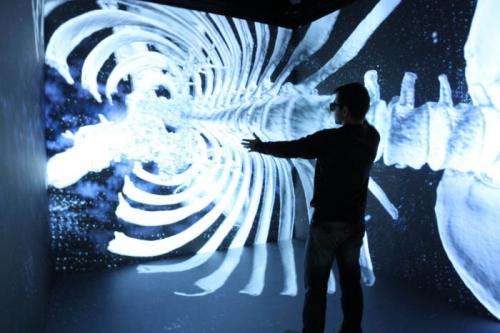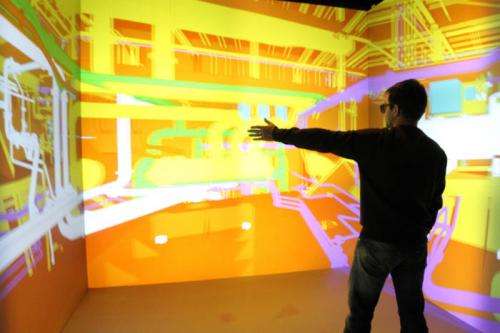New high-performance cave automatic virtual environment that functions with gesture recognition

The Universitat Politècnica de Catalunya BarcelonaTech (UPC) presents a new multi-projector CAVE, designed and built in its entirety by the Virtual Modelling, Visualisation, Interaction and Virtual Reality Research Group (MOVING). This immersive virtual reality system is a pioneering design at world level that is adaptable and based on widely available consumer electronics and computer technology. It consists of four 3 m2 walls (including the floor) that function as screens and has 40 commercial, low-cost projectors that are controlled by 12 PCs. Low cost, versatility and high resolution are some of the characteristics of the new CAVE, which works with a range of projector models that can be substituted at any moment for more modern or cheaper ones.
This architecture is based on a multi-projector scheme in passive stereo that provides high luminosity and 2000x2000 pixel resolution on each of the walls (16 million pixels in total). The uniformity of the final image is achieved using self-calibration software, also designed by MOVING, which adapts each of the 40 projections and guarantees the concordance and continuity of the system.
The self-calibration algorithm is based on the projection of patterns and on the capture of these patterns by four digital cameras that are controlled by a PC. Its own visualisation software guarantees that any digital model can be inspected using the interaction methods defined for the navigation, selection and manipulation of virtual objects.
In the CAVE, users interact wirelessly with objects and the virtual scene through their gestures. The new interaction system, which is at the experimental stage, is intended to be transparent and highly ergonomic. It is based on two Kinect sensors placed at 90 degrees to each other that work in unison, detecting the movements and positions of the main joints of the person inside the CAVE in real time.
The system adapts the image perspective to the head position of the users in real time, allowing them to select and modify the characteristics of the virtual objects with gestures, zooming in or moving them around themselves in order to inspect and see specific areas of these objects more clearly.
The objects are visualised in greater detail and at a lower cost than is offered by current systems. The CAVE thus saves money and time, improving the quality of work, products and technology transfer.

Museums, industrial design and medicine
The new CAVE system is currently being used in applications related to the visualisation of museum pieces, cooperative ship design and medicine, although its sphere of application is broader still, covering industrial design, visualisation of simulation results, molecular design, architecture and urbanism, archaeology and the study of monuments, and geonavigation.
In medicine, biomedicine and biochemistry it is of great help for anatomical volume rendering, surgical simulation and non-invasive examination, the study of molecular dynamics using models and the real-time simulation of critical situations in operating theatres for the training of surgeons.
In industry, the application offers advantages in fields such as the interior and exterior design of vehicles, data training [LV1] and visualisation, virtual prototyping and cooperative design, remote maintenance and ground surveying.
In architecture, urbanism and interior design, virtual reality tools help in planning and decorating spaces.
Leaders in virtual reality
In 2001, the UPC installed the first cave automatic virtual environment in Spain at the Virtual Reality Centre. The system had four walls for projections and used four large CRT technology projectors to generate images. Three-dimensional perception was achieved with active 3D glasses. The visualisation of models required a Silicon Graphics Onyx Infinite Reality Monster supercomputer.
The technology developed for the new multi-projector cave at the UPC—which has an image resolution four times greater than that of the previous incarnation and is three times cheaper—can be used in facilities that require large monocular or stereoscopic projections onto more than one flat surface. The research group MOVING that designed this environment in the framework of the Visualisation, Virtual Reality and Graphic Interaction Centre (ViRVIG) of the UPC and the University of Girona offers it as a service for institutions and businesses, for dissemination and training and for the immersive inspection of 3D digital models. It also offers the possibility of tailoring this technology to specific requirements.
CAVEs are immersive virtual reality environments. They are rooms in cube form (3x3x3 metres), in which projectors are directed at the walls. CAVEs may have three, four, five or six walls, although four (including the floor) is the most common. They were introduced in 1994 by scientists Tom de Fanti and Carolina Cruz-Neira, of the University of Illinois (Chicago, USA), in the framework of the latter's doctoral thesis.
Visualisation of the three vertical walls is achieved by rear projection. After almost 20 years, CAVEs continue to be the best virtual reality systems, both in terms of immersion and presence perception and in terms of ergonomics. The ultimate aim of these systems is for users to feel that they are in a virtual world.
Provided by Polytechnic University of Catalonia



















